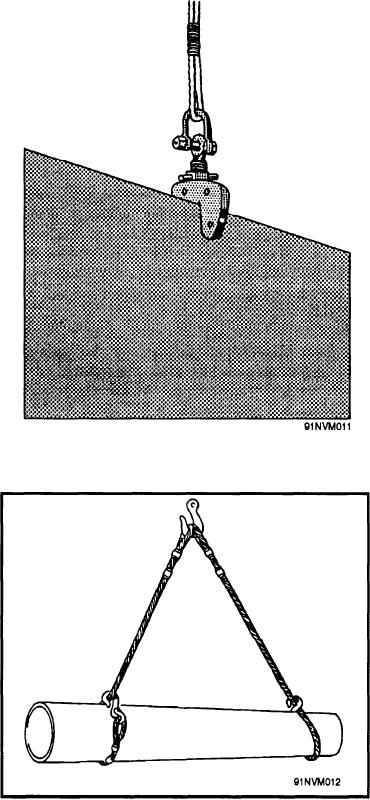
MANUFACTURERS' TECHNICAL MANUALS
are furnished with practically all machinery and
equipment on board ship. Materials and repair parts are
sometimes described in the text of these technical
manuals; usually, details of materials and parts are
given on the drawings. Manufacturers' catalogs of repair
parts are sometimes furnished with shipboard
equipment.
The set of STOCK CARDS that is maintained by
the supply officer is often a valuable source of
information for the identification of repair materials and
repair parts. One of these cards is maintained for each
machinery repair part carried on board.
SHIP'S PLANS, BLUEPRINTS, and other drawings
available on board ship are excellent sources of
information on materials and parts to be used in making
various repairs. Many of these plans and blueprints are
furnished in regular large sizes; some drawings are
being furnished on microfilm to naval shipyards and to
repair ships and tenders.
Handling Materials and Equipment
Figure 2-4.--Clamp for handling heavy plate.
As an HT, your duties will include the supervision
of the handling, stowing, and inventory of all shop
materials and repair parts. The rigging and actual
transferring of the materials, parts, and equipment to
your ship will be done under the supervision of the
Boatswain's Mate. It is your responsibility to furnish the
personnel and supervise the stowage of the materials or
equipment in the proper shop stowage space.
Heavy plate is usually handled with wire rope slings
or straps or with an approved-plate clamp such as the
one shown in figure 2-4. These clamps should NOT be
used for handling bundles of sheet metal, since the
sheets in the middle could slip and cause the entire load
to drop. Bulky items such as bars, strap, and structural
shapes are usually handled with slings or straps. The
chokers shown in figure 2-5 are effective devices for
Figure 2-5.--Chokers for handling pipe.
handling pipe and other materials that must be gripped
tightly; when the hooks are used in pairs, the pull
should be from opposite sides of the load, as shown in
custody of repair parts, storerooms with bins and
figure 2-5.
drawers for individual stowage of repair part items are
generally used instead of the repair parts boxes. The
STOWAGE. --Whenever possible, repair parts
available space and the type of work done in the shop
should be stowed in special storerooms. On small ships,
are factors that determine how much material is stowed
where it may be impracticable to stow repair parts
in the shops and how much is stowed in storerooms.
boxes in storerooms, the boxes are generally located in
(or near) the same space as the machinery for which
Pipe Shop Stowage.--In a tender or repair ship
they are required. Where the supply department has
pipe shop, for example, you will probably not have
2-19

